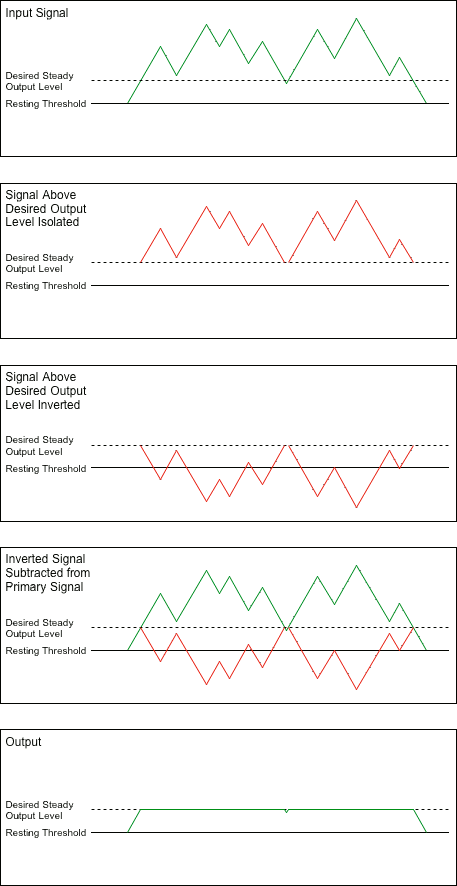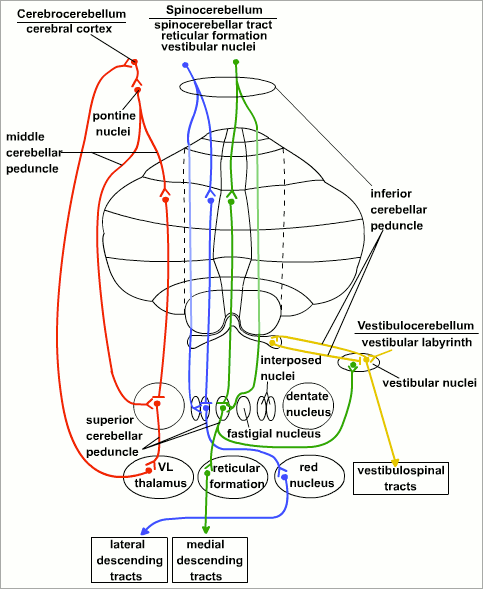The Cerebellum as a Neural Peak Limiter
© Charles ChandlerThe cerebellum is shown to be functioning as a peak limiter, which smoothes out spikes in the signals received from the primary motor cortex (and other structures in the brain).Though the cerebellum only accounts for 10% of the volume of the brain, it contains an estimated 60% of the brain's neurons.1,2,3 Clearly, something very important is going on within this structure. Recent research has found that the cerebellum is interconnected with most other parts of the brain,4 and lesions in the cerebellum can have profound cognitive effects,5 suggesting that its function is inextricably intertwined with human intelligence. And yet all vertebrates have cerebella, including fish, reptiles, birds, and mammals. So the primary purpose of this structure is to handle a problem common to many species.The one problem that all vertebrate brains have in common is that columns in the primary motor cortex go into rapid bursting mode randomly. If these signals were fed directly to the muscles, the result would be spasmodic contractions. In the interest of fine motor control, the spikes in these motor signals have to be smoothed out.Smoothing out spikes is a common problem in electronics. The simplest solution is to employ an inverting peak limiter. First the input signal is split into two pathways. Then one of the signals is attenuated by a fixed amount, and inverted. This signal is then added back to the primary. The result is a steady output, regardless of fluctuations in the input. (See Figure 1.)This same effect can be accomplished easily with neurons. If there are two sets of afferents, with the primary being excitatory, and the secondary being inhibitory, and if both pathways project to the cell bodies of the same output neurons, and if the firing threshold of the inhibitory pathway is higher (i.e., requiring a more vigorous trigger), the inhibitory synapses will selectively attenuate peaks in the input signal, resulting in a smoother output.And this is precisely the configuration in the cerebellum. (See Figure 2.) For each input, the signal is split into two paths. Both of those paths project onto the same output, with the direct path being excitatory, and the secondary path being inhibitory. And when we compare the averaged signals in the primary motor cortex to those coming out of the cerebellum, we see that the spikes have been smoothed out. So this is a neural peak limiter.Figure 2. Principal cerebellar tracts, courtesy UTHealth. Excitatory synapses are designated with a "Y" termination, while inhibitory synapses have a "T" termination.The significance is that as we attempt to simulate more and more sophisticated neural nets, it becomes important to include the contributions of the cerebellum in the simulation.6 In consideration of the number of neurons involved, if we have to allocate computing resources to cerebellar processing in exactly the same way that the brain does, then 60% of the clock cycles will go to that. But if the cerebellum is actually just functioning as a peak limiter, then we can accomplish this very easily in other ways. First, we could simply not bother to be quite so realistic in making the output from the primary motor cortex as spikey as the real thing. Second, if we're working on a robotics project, we could do the peak limiting as electronic (or even electric) post-processing, without taxing the CPUs that are doing the cognitive processing.
References
1. Mann, M. D. (2008): The Nervous System In Action, Chapter 16. ⇧
2. Parsons, L. M. et al. (2000): Neuroimaging evidence implicating cerebellum in support of sensory/cognitive processes associated with thirst. Proceedings of the National Academy of Sciences of the United States of America, 97 (5): 2332 ⇧
3. Stein, K. (2008): Purkinje World. ⇧
4. Parsons, L. M. et al. (1997): Lateral cerebellar hemispheres actively support sensory acquisition and discrimination rather than motor control. Learning & Memory, 4 (1): 49 ⇧
5. Schmahmann, J. D.; Sherman, J. C. (1998): The cerebellar cognitive affective syndrome. Brain, 121 (Pt 4): 561-579 ⇧
6. Abram, I. et al. (2008): Real-time Spiking Networks for Robot Control. ⇧












